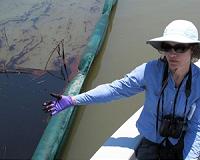 |
New Orleans, Louisiana (AFP) April 16, 2011 The worst maritime oil spill in history began nearly a year ago with a drop in pressure in a poorly drilled well deep in the Gulf of Mexico. It hasn't really ended even though BP's runaway well was eventually capped 87 days later. Here are some key facts about its size and scope. What happened? BP was preparing to temporarily seal an exploratory well 5,000 feet below the surface and 50 miles (80 kilometers) from the Louisiana coast on April 20, 2010 when a massive explosion rocked the Deepwater Horizon, killing 11 workers. The rig sank two days later and oil began gushing out of a riser pipe trapped in the well's blowout preventer. The only proven containment option was a relief well which would take about three months to drill. BP scrambled to find a faster solution as it organized a massive team of nearly 48,000 spill responders and deployed more than 6,900 vessels to contain and collect the oil and lay out more than 13 million feet of protective boom. How big was it? By the time the well was capped on July 15 after a series of failed attempts, some 4.9 million barrels of oil had spewed out of the runaway well. That's nearly 19 times the size of the 1989 Exxon Valdez spill, which led to major US regulatory reforms, and is surpassed only by a 1910 gusher in California and deliberate releases by Iraqi troops during the 1991 Persian Gulf War. It's also enough oil to fill about 312 Olympic-sized swimming pools. How much did it cost? BP took a $40.9 billion charge in 2010 related to the spill and warned shareholders that it could not fully estimate its future liabilities. That included 13.6 billion for spill response. BP set up a $20 billion trust fund to cover compensation claims from fishermen and others affected by the spill but said in its annual report that it can't estimate how much it will eventually have to pay out. The energy giant also faces massive fines and penalties from the US government and will be responsible for restoring the damage to natural resources. BP hopes to recover a significant portion of the cost from its well ownership partners and from subcontractors Transocean, which ran the drilling rig, and Halliburton, which was responsible for the well's flawed cement job. Where did the oil go? About 17 percent of the oil that spewed out of the wellhead was siphoned to the surface and either burned or pumped into waiting ships. The bulk of the remaining 4.1 million barrels remained in the Gulf of Mexico or washed up on 605 miles (975 kilometers) of coastline from Texas to Florida. Louisiana's fragile coastal wetlands were among the most heavily oiled areas. But the massive slicks that spread for hundreds of miles began to disappear shortly after the well was capped. The controversial use of nearly two million gallons (7.5 million liters) of chemical dispersants managed to break down about 16 percent of the oil, a federal assessment found. Another 13 percent was dispersed through natural means -- broken up by waves or gas and pressure as it shot out of the wellhead -- and a further 23 percent evaporated or was dissolved, according to the report released in November Just three percent of the oil was skimmed from the surface and about eight percent was removed through controlled burns. Microbes that feed on natural seeps played a major role in breaking down the oil. Crews continue to actively clean 235 miles (380 kilometers) of shoreline -- primarily dealing with the oil that got mixed with sediment and buried in surf zones and the delicate task of cleaning marshes. They plan to return to some 300 more miles (480 kilometers) after the nesting and tourist seasons are over and then do a full shoreline assessment after hurricane season ends on November 1.
Share This Article With Planet Earth
Related Links Powering The World in the 21st Century at Energy-Daily.com
 Green shoots grow in oiled marsh a year after BP spill
Green shoots grow in oiled marsh a year after BP spillLafitte, Louisiana (AFP) April 15, 2011 Though oil-coated dolphin carcasses and sticky tar balls are washing up on the US Gulf Coast a year after the BP oil spill, the environmental impact appears to be surprisingly limited for now. But scientists have only just begun to analyze the damage and warn it's far too soon to predict what the spill's oily chemical soup might do to the balance of life in Gulf waters. "Some people are ... read more |
|
| The content herein, unless otherwise known to be public domain, are Copyright 1995-2010 - SpaceDaily. AFP and UPI Wire Stories are copyright Agence France-Presse and United Press International. ESA Portal Reports are copyright European Space Agency. All NASA sourced material is public domain. Additional copyrights may apply in whole or part to other bona fide parties. Advertising does not imply endorsement,agreement or approval of any opinions, statements or information provided by SpaceDaily on any Web page published or hosted by SpaceDaily. Privacy Statement |